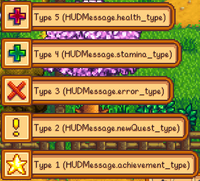模组:常用方法
← 目录
| 页面仍需完善
该页面不完善且缺少信息。您可以通过扩充内容来帮助我们。 |

|
不完整的翻译 本文或部分尚未完全翻译成中文。
欢迎您通过编辑帮助其建设。 |
此页面展示了制作SMAPI模组时常用功能的构建方法。在阅读时,请结合参考模组制作入门和游戏基本架构。
基础技巧
追踪一个值的变化
在写模组时,你可能常常需要了解一个值的变化(什么时候变,变化前后的值分别是多少,等等)。如果该值没有包括在SMAPI内置的事件 (event)中,那么你可以为该值创建一个私有变量,然后在SMAPI的update tick事件中刷新此变量,以达到追踪值变化的目的。
物品 (Items)
物品 代表那些能够放在背包里的东西,比如说工具、农作物等等。
创建一个物品 (Object) 的实例
Object中所有的构造函数:
public Object(Vector2 tileLocation, int parentSheetIndex, int initialStack);
public Object(Vector2 tileLocation, int parentSheetIndex, bool isRecipe = false);
public Object(int parentSheetIndex, int initialStack, bool isRecipe = false, int price = -1, int quality = 0);
public Object(Vector2 tileLocation, int parentSheetIndex, string Givenname, bool canBeSetDown, bool canBeGrabbed, bool isHoedirt, bool isSpawnedObject);
参数parentSheetIndex表示该物品的ID(储存在 ObjectInformation.xnb 文件中)。
在地上生成物品
public virtual bool dropObject(Object obj, Vector2 dropLocation, xTile.Dimensions.Rectangle viewport, bool initialPlacement, Farmer who = null);
// 调用:
Game1.getLocationFromName("Farm").dropObject(new StardewValley.Object(itemId, 1, false, -1, 0), new Vector2(x, y) * 64f, Game1.viewport, true, (Farmer)null);
添加物品到背包 (Inventory)
// You can add items found in ObjectInformation using:
Game1.player.addItemByMenuIfNecessary((Item)new StardewValley.Object(int parentSheetIndex, int initialStack, [bool isRecipe = false], [int price = -1], [int quality = 0]));
例2:
// Add a weapon directly into player's inventory
const int WEAP_ID = 19; // Shadow Dagger -- see Data/weapons
Item weapon = new MeleeWeapon(WEAP_ID); // MeleeWeapon is a class in StardewValley.Tools
Game1.player.addItemByMenuIfNecessary(weapon);
// Note: This code WORKS.
从背包移除物品
取决于你背包的具体情况。很少有情况需要你亲自来调用,因为相关的方法在Farmer类中已经有了。
在大多数情况下,仅需调用 .removeItemFromInventory(Item) 方法。
地点 (Locations)
见 游戏基本架构#地点。
获取所有地点
Game1.locations属性中虽然储存着主要的地点,但是不包括建筑的室内(constructed building interiors)。以下这个方法提供了主玩家的所有地点。
/// <summary>Get all game locations.</summary>
public static IEnumerable<GameLocation> GetLocations()
{
return Game1.locations
.Concat(
from location in Game1.locations.OfType<BuildableGameLocation>()
from building in location.buildings
where building.indoors.Value != null
select building.indoors.Value
);
}
遍历:
foreach (GameLocation location in this.GetLocations())
{
// ...
}
注意:在联机模式中,客机是拿不到上述所有地点的。要解决这一问题,见获取有效的地点。
编辑地图
见模组:地图数据。
玩家 (Player)
自定义贴图 (Custom Sprite)
位置 (Position)
角色(Character) 的位置(Position) 表示他在当前地点(Location) 的坐标。
相对于地图 (Map)
每个地点(location) 都有一个对应的xTile地图(map)。如果以像素(pixel) 为单位,地图左上角坐标代表(0, 0),坐下角则代表(location.Map.DisplayWidth, location.Map.DisplayHeight)。 角色在当前地点的位置有两种表达方式:
- 以像素(pixel) 为单位的绝对(absoulte) 坐标:
Position.X与Position.Y。 - 以图块(tile) 为单位的图块(tile) 坐标:
getTileX()与getTileY()。
常量Game1.tileSize规定,游戏内每个图块(tile) 大小为64x64像素。于是有以下单位换算:
// 绝对坐标 → 图块坐标
Math.Floor(Game1.player.Position.X / Game1.tileSize)
Math.Floor(Game1.player.Position.Y / Game1.tileSize)
// 图块坐标 → 绝对坐标
Game1.player.getTileX() * Game1.tileSize
Game1.player.getTileY() * Game1.tileSize
// 地图大小(以图块为单位)
Math.Floor(Game1.player.currentLocation.Map.DisplayWidth / Game1.tileSize)
Math.Floor(Game1.player.currentLocation.Map.DisplayHeight / Game1.tileSize)
相对于视野 (Viewport)
视野、视口、视窗(Viewport) 代表在当前屏幕上的区域。若以像素计算,其宽高应该与游戏的屏幕分辨率相等,分别为Game1.viewport.Width和Game1.viewport.Height。
玩家相对于视野的位置(像素)可表示为:
Game1.player.Position.X - Game1.viewport.X
Game1.player.Position.Y - Game1.viewport.Y
NPC
自定义NPC
想要自定义NPC,你得修改或添加以下文件:
格式: 具体操作:(往)目标文件夹或文件名
- 添加新文件:Characters\Dialogue\<文件名>
- 添加新文件:Characters\schedules\<文件名>
- 添加新文件:Portraits\<文件名>
- 添加新文件:Characters\<文件名>
- 在已有文件中添加新的条目:Data\EngagementDialogue(可结婚NPC)
- 在已有文件中添加新的条目:Data\NPCDispositions
- 在已有文件中添加新的条目:Data\NPCGiftTastes
- 在已有文件中添加新的条目:Characters\Dialogue\rainy
- 在已有文件中添加新的条目:Data\animationDescriptions(在行程(schedule) 中增加自定义的动画)
以上所有的操作都可以通过IAssetLoaders/IAssetEditors或者Content Patcher做到。
最后,你需要调用NPC的构造器来创建实例。
public NPC(AnimatedSprite sprite, Vector2 position, int facingDir, string name, LocalizedContentManager content = null);
public NPC(AnimatedSprite sprite, Vector2 position, string defaultMap, int facingDir, string name, Dictionary<int, int[]> schedule, Texture2D portrait, bool eventActor);
public NPC(AnimatedSprite sprite, Vector2 position, string defaultMap, int facingDirection, string name, bool datable, Dictionary<int, int[]> schedule, Texture2D portrait);
// 调用:
Game1.getLocationFromName("Town").addCharacter(npc);
用户界面 (UI)
用户界面(User-interface、UI) 是指一系列有关界面元素(如按钮、列表框、下拉框等等)以及它们组合起来呈现的画面(如菜单、HUD等等)。
//TODO:欢迎补充UI方面的内容。
HUD消息
HUD消息是指你屏幕左下角时常弹出来的消息框。以下是它的构造函数(不包括一部分无关的):
public HUDMessage(string message);
public HUDMessage(string message, int whatType);
public HUDMessage(string type, int number, bool add, Color color, Item messageSubject = null);
public HUDMessage(string message, string leaveMeNull)
public HUDMessage(string message, Color color, float timeLeft, bool fadeIn)
可选的样式(type):
- 成就
HUDMessage.achievement_type - 新任务
HUDMessage.newQuest_type - 错误
HUDMessage.error_type - 体力值
HUDMessage.stamina_type - 生命值
HUDMessage.health_type
颜色(color):
第1、2个构造器并没有给出表示颜色的参数,此时颜色默认为Color.OrangeRed。
若使用第4个构造器,颜色则与游戏内文字颜色一样。
特别:
- public HUDMessage(string type, int number, bool add, Color color, Item messageSubject = null); 支持消息内容扩展。常用于金钱相关。
- public HUDMessage(string message, string leaveMeNull); 左侧没有图标框。
- public HUDMessage(string message, Color color, float timeLeft, bool fadeIn); 文字渐入效果。
Game1.addHUDMessage(new HUDMessage("MESSAGE", 3));
示例2: 弹出一个纯文字的消息框。
Game1.addHUDMessage(new HUDMessage("MESSAGE", "")); // second parameter is the 'leaveMeNull' parameter
菜单指绘制于最顶层的UI,能够接受用户输入。比方说,当你按下ESC或B键时呈现的GameMenu就是一个菜单。
菜单的值储存在Game1.activeClickableMenu,当该字段不为null时,其值便能呈现出一个菜单了。
每个菜单不尽相同,请阅读代码来了解其运作方式。你可能经常需要了解GameMenu的当前栏目 (tab),这是一个示例:
if (Game1.activeClickableMenu is GameMenu menu)
{
// 获取栏目页
IList<IClickableMenu> pages = this.Helper.Reflection.GetField<List<IClickableMenu>>(menu, "pages").GetValue();
// 方法1:比较栏目的ID
if (menu.currentTab == GameMenu.mapTab)
{
...
}
// 方法2:比较菜单类型
switch (pages[menu.currentTab])
{
case MapPage mapPage:
...
break;
}
}
如果你想要自定义菜单,请继承自IClickableMenu,将对象分配给Game1.activeClickableMenu。 一个菜单基本上重写了一些方法,如draw、receiveLeftClick 等等。 draw方法绘制屏幕上的元素;receiveLeftClick 方法处理左键点击事件。 你通常可以使用一些游戏封装好的类作为菜单元素,如ClickableTextureButton。
这里提供了一个简单的例子,这是Birthday Mod的菜单。
对话框 (DialogueBox)
对话框有许多变种,比如有种对话框能够选择想要的对话内容。
如果想换行,请输入"^"。
下面是一种不带选项的对话框示例:
using StardewValley.Menus; // 引用DialogueBox类的命名空间
string message = "This looks like a typewriter ... ^But it's not ...^It's a computer.^";
Game1.activeClickableMenu = new DialogueBox(message);
邮件 (Mail)
// 未翻译
概述
// 未翻译
注入静态内容 (Inject static content)
// 未翻译
客户端调用静态内容 (Send a letter with static content)
// 未翻译
注入动态内容 (Inject dynamic content)
// 未翻译
客户端调用动态内容 (Send a letter with dynamic content)
// 未翻译
其他 (Other)
简单动画(animation) 的添加
location.temporarySprites.Add(new TemporaryAnimatedSprite(...));
详见TemporaryAnimatedSprite类。
播放一段声音
location.playSound("SOUND"); // "SOUND"为声音的名字
详见声音名字一览。
开源 (Open Source)
详见模组大全中源代码(source)一栏。

